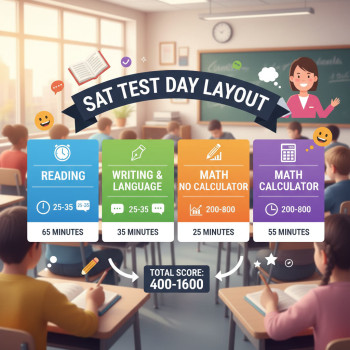Why stress matters for the Digital SAT — more than you might think
Take a breath. Close your eyes for two seconds. That tiny pause you just gave yourself is the difference between a scattered test-taker and someone who walks into the Digital SAT calm, collected, and ready to perform. Stress isn’t just an emotional hiccup; it changes how your brain processes information, how quickly you retrieve facts, and how well you sustain attention for long adaptive sections. The good news? Stress is manageable — and when you manage it well, your SAT scores often reflect that improvement.
The science in plain language
When you’re nervous, your body releases stress hormones like adrenaline and cortisol. That rush can help in short bursts (think of it as turning up the volume), but too much for too long muddies thinking, narrows attention, and makes it harder to recall formulas, vocabulary, or steps to solve a problem. On the Digital SAT — with its adaptive sections, timer, and new testing platform — staying mentally flexible is critical. Lower stress supports clearer thinking, steadier pacing, and better decision-making when an answer looks ambiguous.
Common stress triggers before and during the test
Understanding where your stress comes from is the first step in controlling it. Here are triggers students commonly face, and a quick sense of why each one matters:
- Uncertainty about what the test will look like — unfamiliar tech or adaptive format can create anticipatory anxiety.
- Fear of running out of time — rushing causes careless errors or skipped questions.
- Perceived personal stakes — scholarships, college admissions, or family expectations increase pressure.
- Poor sleep, caffeine overload, or inconsistent routines — physical state shapes mental state.
- Last-minute cramming — stimulates panic rather than long-term learning.
Spot the cascade
Stress usually shows up in small ways first: tightened shoulders, a mind that jumps between thoughts, or repeatedly changing answers. Left unchecked, those small signs cascade into full-blown test anxiety. The most effective approach is practical and preventive: reduce triggers ahead of time, practice coping skills, and rehearse test-day routines so the real exam feels like a familiar rehearsal instead of a surprise performance.
Daily habits that reduce stress and sharpen SAT performance
You don’t have to overhaul your life to make big gains. Small, consistent habits rewired over weeks give you the calm and mental stamina needed for the Digital SAT.
- Sleep like it matters — because it does. Aim for consistent sleep: 8–9 hours in the weeks before the test. Sleep consolidates memory and improves problem-solving.
- Nutrition and hydration: Balanced meals and steady hydration keep energy and focus stable. Avoid heavy sugar spikes before practice tests or the exam.
- Move your body: Short workouts or brisk walks release endorphins and reduce baseline anxiety.
- Short, meaningful practice sessions: Consistent 30–60 minute blocks beat all-night cramming — especially if paired with active review strategies and timed Digital SAT practices on Bluebook or other official formats.
- Mindfulness and breathwork: Five minutes of breathing exercises every morning builds a calm baseline you can call on during the test.
Sample weekly routine
Here’s a realistic weekly template that balances skill-building and stress reduction without burning you out.
| Day | Focus | Stress-management activity |
|---|---|---|
| Monday | Practice adaptive section (timed) | 10-minute breathing & light stretching |
| Tuesday | Targeted grammar & vocab | Evening walk, screen-free hour before bed |
| Wednesday | Math problem set (calculator skills) | Short HIIT or sports; healthy dinner |
| Thursday | Reading passages (timed) | Guided mindfulness app or breathing practice |
| Friday | Review errors & concepts | Social time/relaxing hobby |
| Saturday | Full-length Digital SAT practice (Bluebook) | Recovery routine: foam rolling, long walk |
| Sunday | Light review, plan week ahead | Early bedtime, tech curfew |
Practical techniques to calm nerves right before and during the test
When the clock starts and your heart races, technique matters. These are field-tested tactics that students can use instantly.
- Box breathing (4-4-4-4): Inhale for 4 seconds, hold 4, exhale 4, hold 4. Repeat 3–5 times to lower heart rate and clear your mind.
- Grounding checklist: Feet flat, shoulders relaxed, pen ready, read first line of passage — small actions that orient you and reduce catastrophic thinking.
- One-question-at-a-time rule: If your thoughts spiral, forcibly bring attention to the current question only. You’ll often find the answer becomes clearer when you limit your mental scope.
- Eliminate the “black hole” of time: Use the Digital SAT’s timer smartly — set micro-goals (e.g., spend no more than 1.5 minutes on medium-difficulty multiple-choice math) rather than staring at the countdown.
- Planned breaks during practice: The Digital SAT format has its rhythm. Rehearse taking short, scheduled micro-breaks during practice sessions so the real test-day pauses feel natural, not panicked.
What to do if panic hits mid-test
First: it happens to almost everyone at some point. Pause for 20 seconds. Breathe. Remind yourself of one anchor sentence like, “I prepared for this; I can do this question.” Then move on to the next question. The goal is to interrupt the panic and re-enter a steady, productive mindset.
Study strategies that reduce test-day stress by building real confidence
Confidence isn’t a feeling you fake; it’s a skill you build. The more purposefully you practice with the same conditions you’ll face on test day — including device setup, timing, and question types — the less novelty there is to trigger anxiety.
- Simulate the test environment: Take full-length practice tests on the Bluebook app, using a similar device and the same time blocks you’ll have on exam day.
- Error log and pattern spotting: Keep an error journal. Note not just the question you missed, but why — careless mistake, timing, content gap, or misread direction. Patterns let you fix the root cause rather than patch symptoms.
- Active recall and spaced repetition: Use flashcards and short retrieval sessions over weeks to ensure material moves from short-term to long-term memory.
- Practice with pacing strategies: Train for tempo, not speed. Knowing how to allocate minutes per question type reduces in-test second-guessing.
How tutoring can reduce stress — the right way
Working with a tutor is more than improving raw scores; a good tutor helps you build a reliable routine, provides emotional support, and teaches coping techniques tailored to you. Personalized 1-on-1 guidance and tailored study plans (like those offered by Sparkl) can reduce overwhelm by breaking practice into manageable, confidence-building steps. Tutors also model exam strategies and give immediate feedback, which shortens the path from repeated mistakes to consistent competence.
Exam-day checklist to minimize surprises and anxiety
Logistics are stress’s best friend. Prevent avoidable stressors with a checklist you follow every test day.
- Install and test Bluebook at least 30 days before your test.
- Charge and re-check your device; bring a backup charger or battery pack if allowed.
- Pack a simple, balanced breakfast and a water bottle (as per test rules).
- Wear comfortable layers; testing rooms can be cold or warm.
- Arrive early to the test center or school-day room to settle in.
- Bring a written, simple mantra: a few words you can say to yourself if nerves spike (e.g., “steady, one at a time”).
Morning-of routine
Keep it boring and consistent. Eat, hydrate, breathe, and run a 3–5 minute warm-up of box breathing. Avoid last-minute review of high-volume content; instead, briefly glance at your error log or a mini-sheet of high-yield reminders you’ve prepared.
Measuring stress and tracking progress
If you want to reduce stress systematically, measure it. Use simple metrics and track them alongside practice-test progress.
- Self-rated anxiety score (1–10) before and after each practice test.
- Number of questions left unanswered due to time pressure.
- Frequency of mind-wandering during practice (pause, rate, resume).
Sample tracking table
| Practice Date | Anxiety (1-10) | Score | Major issue (timing/content) | Action plan |
|---|---|---|---|---|
| Aug 10 | 7 | 1150 | Rushed reading | Timed reading drills; 10m daily |
| Aug 24 | 5 | 1220 | Careless math errors | Slow practice; error log focus |
Real-world examples: stress management that changed results
Stories are powerful because they’re practical. Here are two condensed examples of students who improved not just their scores but their testing experience.
Case A: Mia — from panic to pace
Mia consistently ran out of time on reading sections. Instead of repeating more untimed practice, she started pacing drills: 15 minutes per passage with specific annotation targets. She paired this with breathing before each passage and a nightly 5-minute error review. The result: she reduced careless mistakes, dropped her pre-test anxiety score from an 8 to a 4, and gained 90 points in one month.
Case B: Jordan — breaking the perfection trap
Jordan was stuck in a loop of second-guessing answers. His tutor introduced a checkpoint routine: after answering, he had 8 seconds to decide whether to lock in or flag for review. He practiced this during digital mock tests so it became automatic. The habit broke his overthinking, improved pacing, and increased his composite score while lowering test-day fatigue.
When to ask for more structured help
If your anxiety is consistently high (impacting sleep, appetite, or school performance), it’s time to escalate. Talk to a school counselor, parent, or medical professional about strategies beyond study habits — including cognitive-behavioral techniques or professional support. For test-specific work, consider structured tutoring that combines content coaching with stress management. Personalized tutoring programs (like Sparkl’s tailored plans and expert tutors) are helpful because they address both knowledge gaps and the emotional side of test preparation: targeted lessons, practice tailored to your pace, and AI-driven insights to track improvement make the prep process less chaotic and more strategic.
Putting it all together: a 30-day stress-smart plan
Here’s a compact 30-day plan you can adapt. The goal is to improve both your skills and your stress resilience.
- Week 1: Baseline — take a full Digital SAT practice on Bluebook. Record anxiety levels and review error patterns.
- Week 2: Foundation — daily 30–45 minute focused practice (math/reading alternate days), nightly 5-minute error log, and daily breathing practice.
- Week 3: Pacing & Simulation — two full-length timed practices, one with device and environment replication. Add one session with a tutor or coach to refine strategy.
- Week 4: Taper & Routine — reduce volume, rehearse test-day checklist, get consistent sleep, and maintain light practice with stress-management anchors.
How to adapt based on your results
If your anxiety rating doesn’t drop after two simulated tests, add targeted mental skills: brief CBT-based reframing (write down worst fears and realistic counters) or short sessions with a counselor. If scores improve but anxiety remains, keep practicing under simulated conditions until the routine feels automatic.
Final thoughts: stress is part of the process — and you can master it
Stress doesn’t vanish before a big test, but it becomes manageable when you address it on several fronts: physical health, practiced routines, mental skills, and targeted study. Students who combine skillful prep with steady stress-management often find that their performance reflects not only knowledge, but confidence and resilience.
If you feel stuck, reach out for structured support. Personalized 1-on-1 guidance and tailored study plans can make the difference between random practice and strategic progress — and the emotional safety net that comes from a trusted coach helps quiet the noise so you can perform your best on test day.
One last practical mantra
Before you go: bookmark this short mantra and use it when nerves arrive: “Breathe. One question. One moment.” Repeat it, and then apply the techniques in this article: a predictable routine plus small, intentional actions will keep stress from stealing your focus. You’ve prepared — now practice calm, and you’ll let your preparation show up where it counts.
Good luck — and remember: progress is not always a number on a score report. It’s how you feel walking out of that room: steadier, clearer, and proud of the effort you put in.
















No Comments
Leave a comment Cancel